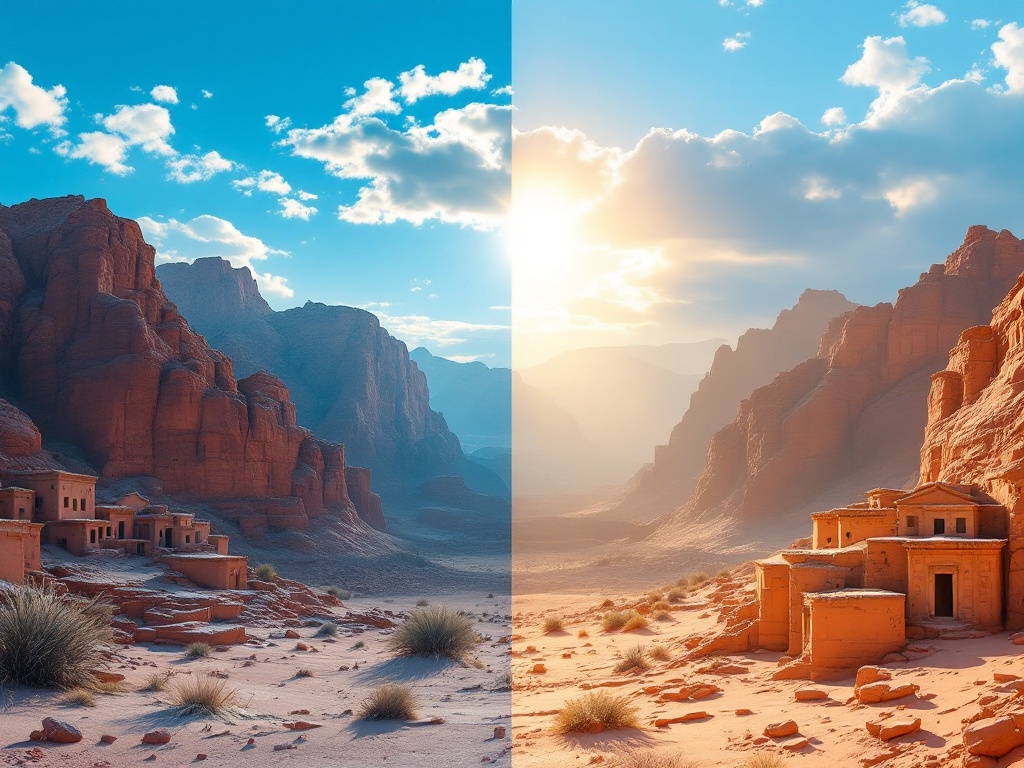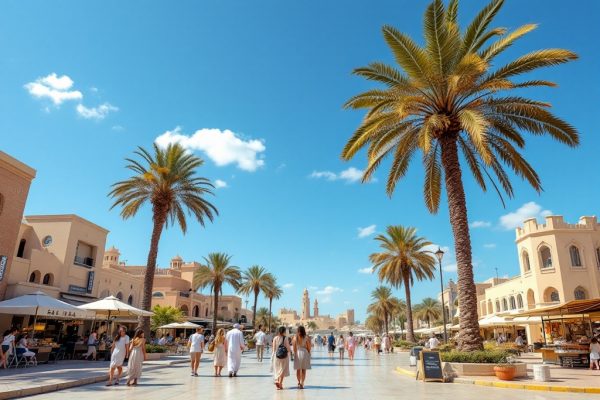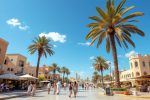Weather in Petra, Jordan Throughout the Year
Dreaming of exploring the lost city of Petra? Discover the best time to experience this ancient wonder! Petra’s desert climate offers hot summers, exceeding 95°F (35°C), and mild winters with chilly nights near freezing. Learn how Petra’s weather changes throughout the year, from the wettest months of January and February to the scorching dry season from June to September. Plan your unforgettable adventure with our comprehensive guide to Petra’s climate, complete with monthly breakdowns and practical tips for a comfortable and safe journey. Uncover the secrets of Petra now!
Important information

- Petra has a hot desert climate with scorching summers (over 35°C/95°F) and mild winters (10-15°C/50-59°F), with cold nights near freezing.
- Rainfall is scarce, mainly between November and March, peaking in January and February.
- The best time to visit is during spring (April-June) for pleasant temperatures (19-32°C/66-90°F) and minimal rain.
- Summer visits require precautions due to intense heat: stay hydrated, wear light clothing, use sunscreen, and explore during cooler parts of the day.
- Pack layered clothing for fluctuating temperatures, sturdy shoes, and rain gear for winter or early spring.
Climate and Weather in Petra, Jordan
Petra, situated in the Jordanian desert, has a subtropical climate characterized by hot summers and mild winters. Rainfall is scarce, mainly concentrated between November and March, peaking in January and February, averaging around 362 mm annually. Summer temperatures often surpass 35°C (95°F) with low humidity. Winter days are comfortable, ranging from 10°C to 15°C (50°F to 59°F). However, winter nights can get quite cold, occasionally nearing freezing at 0°C (32°F).
Subtropical Desert Climate Characteristics
Petra’s climate is a hot desert (BWh under the Köppen-Geiger system). Summers are scorching and dry, with average temperatures over 30°C (86°F). Winters are mild, short, and sometimes rainy. The annual rainfall is less than 100 millimeters (4 inches).
Temperature Fluctuations and Extremes
Petra’s desert climate brings dramatic temperature changes throughout the year. January, the coldest month, has lows around 15°C. In contrast, July and August are the hottest, with August averaging highs of 33°C. These wide daily temperature fluctuations are typical in Petra, so visitors should be prepared.
Annual Precipitation Patterns
Petra experiences an extremely arid climate, receiving an average of just 200 mm of rainfall annually. January and February are the wettest months, each with approximately 48 mm of rain. Rainfall is most abundant in the beginning of the year, becoming exceptionally scarce between April and June.
Monthly Weather in Petra
January: 46-54°F (8-12°C), rainfall common.
February: 50-57°F (10-14°C), rainfall continues.
March: 57-68°F (14-20°C), drier weather.
April: 64-75°F (18-24°C), drier weather.
May: 72-82°F (22-28°C), low humidity.
June: 86°F (30°C) or higher, hot and dry.
July: Up to 95°F (35°C), hottest month.
August: Up to 95°F (35°C), hottest month.
September: 86°F (30°C) or higher, hot and dry.
October: 68-79°F (20-26°C), cooler temperatures.
November: 57-68°F (14-20°C), cooler temperatures.
December: 50-61°F (10-16°C), increased humidity.
January: The Coldest and Wettest Month
Planning a January trip to Petra? Be prepared for daytime temperatures around 15°C, dropping to a chilly 5°C at night. Expect significant rainfall, averaging 48mm, so pack for both cool and wet conditions.
February: Continued Rainfall
February in Petra is similar to January, experiencing significant rainfall and consistently low temperatures throughout the month. The winter chill persists.
March and April: Transition to Drier Conditions
Petra experiences drier days in March and April as temperatures rise and rainfall decreases. This transitional period marks the shift from winter’s wet conditions to the dry heat of summer.
May: Lowest Humidity of the Year
May marks the start of summer in Petra, Jordan. Humidity drops to an average of 40%, making it the driest month. Temperatures rise, and rainfall is virtually nonexistent.
June to September: Dry and Hot Summer
Petra’s summer, from June to September, is a hot and dry season with no rainfall. June offers the longest daylight hours but also the strongest UV radiation, so expect scorching temperatures often surpassing 35°C (95°F) and sometimes peaking at 40°C (104°F) or even higher. Be sure to pack appropriate clothing and essentials for this intense heat.
October and November: Cooling Temperatures
Experience Petra in the pleasant embrace of October and November, where temperatures range from a comfortable 15°C to 25°C (59°F to 77°F). This period marks a welcome shift from the intense summer heat to the milder winter months, offering clear skies and reduced rainfall.
December: Increased Humidity
Winter arrives in Petra with December’s chill, bringing increased humidity around 65% and cool temperatures, along with a chance of rain.
Daylight and Sunshine in Petra
Petra’s summers are characterized by extended daylight hours, providing almost 14 hours of daylight and an average of 10 hours of sunshine.
Winters in Petra offer shorter days with around 10 hours of daylight and only 6 hours of sunshine.
Spring and autumn in Petra offer a pleasant balance between these seasonal extremes.
Daylight Hours Across Seasons
Petra, Jordan, experiences varying daylight hours throughout the year. In June, days are longest, offering approximately 14.1 hours of sunlight. Winter days are considerably shorter.
Sunshine Duration and Variability
Petra enjoys an average of 7 hours of sunshine in both January and December. Summer days offer the most daylight hours, while winter days are shorter. This variation is due to the Earth’s orbit and the changing angle of the sun.
Best and Worst Times to Visit Petra
Plan your Petra trip for spring, ideally in April, May, or June, for the best experience. The pleasant weather during these months makes exploring enjoyable. Summer’s intense heat can make sightseeing challenging.
Optimal Visiting Periods: April to June
Plan your trip between April and June for ideal weather. Expect comfortable temperatures, ranging from 19°C to 32°C, with minimal rainfall.
Challenges of Visiting in Peak Summer
Planning a summer trip to Petra? Be prepared for the desert heat. High temperatures, low humidity, and intense sun can create risky conditions, increasing the chances of heatstroke and sunburn. However, with these precautions, you can explore this wonder safely:
- Carry ample water to stay hydrated throughout your visit.
- Wear light-colored, loose-fitting clothing to stay cool.
- Apply high-SPF sunscreen regularly.
- Explore Petra in the cooler early mornings or late afternoons to limit sun exposure.
Enjoy your trip!
Practical Tips for Weather in Petra
Clothing: Pack light, breathable clothing for scorching summers exceeding 95°F (35°C). Layers and a waterproof jacket are essential for mild winters with nighttime temperatures around 41°F (5°C).
Footwear: Sturdy walking shoes are crucial year-round.
Essentials: Given Petra’s arid climate, sun protection and hydration are vital, especially during hotter months. Layering helps regulate body temperature throughout the day.
Weather Check: Before you go, check the weather forecast, as flash floods can occur, particularly in winter and early spring.
Heat Exposure and Sun Protection
Visiting Petra in the summer, particularly June and July, means facing intense sun and very high UV indexes. Protecting yourself with a hat and sunscreen is essential.
Importance of Hydration and Layered Clothing
Visiting Petra involves key preparations. Pack plenty of water to combat the desert’s aridity, especially during summer’s peak. Layered clothing is also essential due to extreme temperature fluctuations between day and night.
Recommendations for Outdoor Activities
Explore Petra in the cool morning or late afternoon to avoid the midday sun. Discover scenic trails and hidden tombs, and marvel at the majestic Monastery. For a comfortable and unforgettable adventure, pack water, dress in layers, and apply sunscreen.












